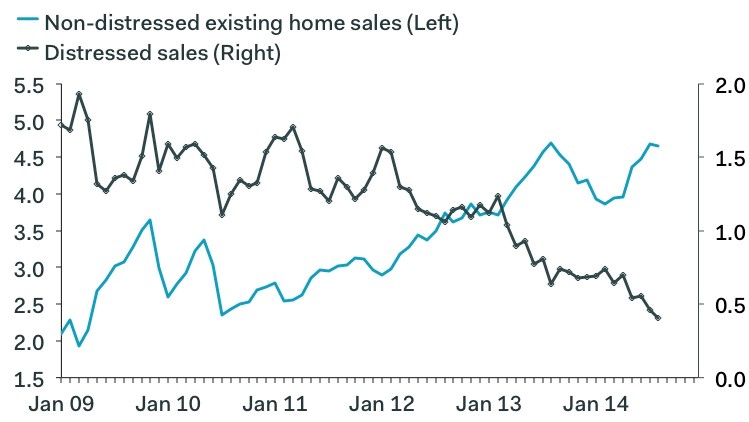Investors who have been burning through big bankrolls of cash to buy up U.S. homes pulled away from the housing market last month — but that could spell opportunity for other buyers, the National Association of Realtors said Monday.
The real estate trade group said the retreat by cash investors is a big reason why, after four straight months of gains, sales of existing homes took a disappointing slide in August, dropping 1.8 percent to a seasonally adjusted annual rate of 5.05 million. Individual investors accounted for 12 percent of sales of existing homes in August, down from 16 percent the month before and 17 percent a year earlier.
Related: Two Housing Markets for the Two Americas
“This means that investors bought 26.3 percent fewer homes last month,” IHS Global Insight economist Stephanie Karol pointed out in an email to clients.
All cash sales fell from 29 percent in July to 23 percent in August, the second consecutive monthly drop. That left cash deals at their lowest share of overall sales since December 2009.
Overall sales activity still remains stronger than it had been earlier in the year, but August sales gains in the Northeast and Midwest were more than offset by weakness in other regions, according to the Realtors report. “Losses were concentrated in the West and South, where investors had been playing an outsized role in supporting sales,” Diane Swonk of Mesirow Financial noted in a blog post.
Investors scooping up properties in all cash deals, including lots of homes in foreclosure, have been boosting the home price recovery, but the National Association of Relators said a pullback by investors could actually be good for the housing market. "On the positive side, first-time buyers have a better chance of purchasing a home now that bidding wars are receding and supply constraints have significantly eased in many parts of the country,” said Lawrence Yun, chief economist for the trade association. "As long as solid job growth continues, wages should eventually pick up to steadily improve purchasing power and help fully release the pent-up demand for buying.”
Related: The 10 Most Expensive Home Sales in America
For now, though, the drop off in interest from investors has yet to be made up in new activity from first-time homebuyers. “Families are picking up the pace, but not quickly enough to keep the headline figure expanding,” said IHS's Karol. Sales to families grew by nearly 3 percent since July and by 0.5 percent over the previous August, marking the first year-over-year growth since October 2013.
Still, tight lending standards and stagnant wages are still keeping would-be homebuyers on the sidelines. “We think home sales are running out of steam now that the post-winter rebound is over and the buyers for distressed properties fade away,” Ian Shepherdson, chief economist at Pantheon Macroeconomics, wrote to clients (see his chart below). “The implied level of distressed sales has halved since last summer, but tight mortgage lending standards mean that regular non-distressed buyers cannot fill the gap in the near-term.”

Many millennials, struggling with large amounts of student debt and a job market that has only recently shown stronger momentum, are still not in the market and the formation of new households has still not rebounded strongly enough to drive stronger sales numbers. According to new Census Bureau data, about 500,000 new households were formed between the first quarter of 2013 and the first quarter of 2014 — “far below expectations,” Karol notes. The number of households headed by a millennial grew by just 1,000.
Related: The 10 Best Cities for 2014 College Grads
At the same time, Karol writes, the average household size grew a bit over the course of 2013, “supporting the conclusion that household formation is down because more Americans are ‘doubling up’. If this is the case, it implies higher demand for larger homes, but should result in a smaller number of overall sales.”
Overall, the median home sold in August went for $219,800, representing a relatively modest a 4.8 percent increase over a year earlier. The unsold inventory of homes was 4.5 percent higher than it had been in August 2013. Those slower gains in home prices could really be healthy for the housing market, but only if new buyers have a chance to get in the game. That remains in question.
“There is some hope first-time buyers will come back with recent increases to employment and some modifications of student loans,” Swonk wrote. “Those hopes look a bit premature, however, given ongoing constraints on wages combined with the paperwork required for borrowers to modify student loans to make them more affordable.”
Top Reads from The Fiscal Times:





